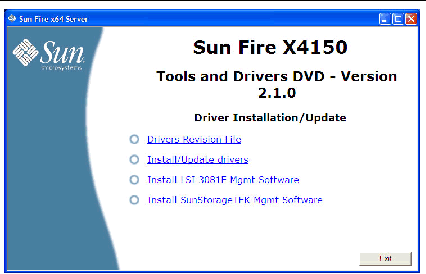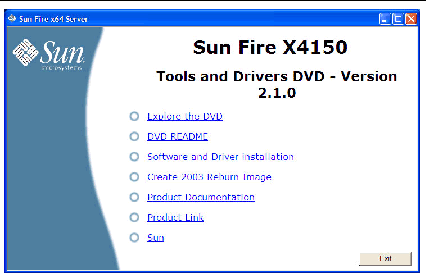| C H A P T E R 8 |
|
Update the Critical Server-Specific Drivers |
This chapter describes how to update the Windows Server installation with server-specific device driver software.
This chapter contains the following sections:
The procedures in this chapter assume that you already:
Sun provides a wizard to install Sun server-specific drivers and supplemental software. The Sun Fire Installation Package wizard may be started from the main menu of your server’s Tools and Drivers CD/DVD. You may also choose to install the drivers manually from the Tools and Drivers CD/DVD from a command line.
Follow the directions for using either method are described below:
|
1. Insert the Tools and Drivers CD/DVD into the server’s CD/DVD drive. The CD will autostart.
The Tools and Drivers main menu displays.
FIGURE 8-1 Sun Fire X4150 Tools and Drivers Main Menu Example

2. At the main menu, click Software and Driver Installation.
The Driver Installation/Update screen displays.
FIGURE 8-2 Sun Fire X4150 Driver Installation/Update Page Example

3. Click the Install/Update drivers option.
The Install/Update drivers wizard begins. Follow the on-screen instructions to install the critical drivers for your server.
| Note - To utilize the additional features of the Intel PROSet network interface software, such as NIC teaming, fault tolerance, load balancing, etc., refer to the section Additional Information for Supplemental Software after you have completed updating the critical server drivers and installing supplemental software. |
4. When done, proceed to Installing Supplemental Software.
|
If your server has an on-board DVD drive, you can manually install the drivers directly on the server using the Sun Fire Server Tools and Drivers CD/DVD.
1. Insert the Sun Fire Server Tools and Drivers CD/DVD into the CD/DVD drive. If the CD autostarts, click the close icon at the main menu.
2. Using Windows explorer, navigate to the chipset drivers:
cdromdrive:\drivers\windows\chipset
Where cdromdrive is the drive letter of the CD/DVD drive containing the Tools and Drivers CD/DVD.
3. Double-click on the .exe executable file to start the installation process.
Follow the on-screen instructions to install the chipset drivers. When done, proceed to the next step.
4. Using Windows explorer, navigate to the Ethernet drivers:
cdromdrive:\drivers\windows\IntelNIC
b. Right-click on the NIC with the yellow bang (!) and choose Update.
c. Select No, not at this time, and click Next.
d. Select Install from a List or Specific Location, and click Next.
e. Click Browse, and point to the NIC driver on the CD/DVD path:
d:\drivers\windows\IntelNIC\2003\2003_version
Where version is the version of Windows, 32-bit/64-bit.
| Note - To utilize the additional features of the Intel Proset software, such as NIC teaming, fault tolerance, load balancing, etc., refer to the section Additional Information for Supplemental Software after you have completed updating the critical server drivers and installing supplemental software. |
5. Using Windows explorer, navigate to the TPM drivers:
cdromdrive:\drivers\windows\tpm
b. Double-click on the executable.
Follow the installation wizard to install TPM drivers. When done, proceed to the next step.
6. Using Windows explorer, navigate to the AST2000 display drivers:
cdromdrive:\drivers\windows\display\version
Where version is the version of Windows: 2003 32-bit/64-bit, or 2008 32-bit/64-bit.
a. Open the Windows Device Manager.
b. Right-click the display driver, and choose Update.
c. The Hardware Update Wizard appears.
d. Select No, not at this time, and click Next.
e. In the dialog box that follows, select Install from a list or specific location and click Next.
f. Click Browse and navigate to the following directory on the Tools and Drivers CD/DVD:
cdromdrive:\drivers\windows\display\version
Where version is the version of Windows: 2003 32-bit/64-bit, or 2008 32-bit/64-bit.
g. Click OK, and then click Next.
The AST2000 driver is installed.
7. For Windows Server 2003 SP1 installations, use Windows explorer to navigate to the IPMI driver:
cdromdrive:\utilities\ipmitool\Windows\version
Where version is the version of Windows Server 2003 SP1: 32-bit or 64-bit.
a. Double-click the ipmievd-version.exe executable to install the IPMI Management Driver.
Where version is the version number for the software.
b. Double-click the ipmitool-version.exe executable to install the IPMItool.
| Note - Additional setup may be required to use the IPMItool. Refer to Completing the IPMItool Installation for additional instructions. |
9. Proceed to Installing Supplemental Software.
There are supplemental software components available for your Sun Fire server. The software supported for your server is listed in the following table.
|
LSI MegaRAID Storage Manager--Allows you to configure, monitor, and maintain RAID on the LSI SAS3081E-S integrated RAID controller. Refer to Managing RAID Using the MegaRAID Storage Manager (MSM). |
||
|
LSI SAS-IR Storage SNMP Agent--Captures SNMP data on the LSI SAS3081E-S integrated RAID controller. Requires the Windows Component for SNMP service for operation. |
||
|
Sun STK RAID Manager--Allows you to configure, administer and monitor RAID on the Sun StorageTek integrated RAID controller (Adaptec-based). Refer to Managing RAID Using the StorageTek RAID Manager. |
Choose a method for installing supplemental software on your server:
|
1. Insert the Tools and Drivers CD/DVD into the server’s CD/DVD drive. The CD will autostart.
The Tools and Drivers main menu displays.
FIGURE 8-3 Sun Fire X4150 Tools and Drivers Main Menu Example

2. At the main menu, click Software and Driver Installation.
The Driver Installation/Update screen displays.
FIGURE 8-4 Sun Fire X4150 Driver Installation/Update Page Example

4. Follow the on-screen instructions to install the management software for your RAID controller.
When done, proceed to Additional Information for Supplemental Software to learn more about your supplemental software.
|
If your server has an integrated DVD drive, you can manually install the supplemental software for your integrated RAID controller directly on the server using the Sun Fire Server Tools and Drivers CD/DVD.
1. Insert the Sun Fire Server Tools and Drivers CD/DVD into the CD/DVD drive. If the CD autostarts, click the close icon at the main menu.
2. Using Windows explorer, navigate to the appropriate RAID controller software directory:
cdromdrive:\RAIDmgmt\StorageTEK\windows\version
cdromdrive:\RAIDmgmt\LSI\windows\version
Where cdromdrive is the drive letter of the CD/DVD drive containing the Tools and Drivers CD/DVD, and version is the version number for the software.
3. Double-click on the .exe executable file to start the installation process.
Follow the onscreen instructions to install the software.
When done, proceed to Additional Information for Supplemental Software to learn more about your supplemental software.
This section lists additional information about Sun supplemental software for your server. This information includes:
The MSM program enables you to configure the LSI-based integrated RAID controller, physical disk drives, and virtual disk drives on your system. The Configuration Wizard in the MSM program simplifies the process of creating disk groups and virtual disk drives by guiding you through several simple steps to create your storage configurations.
MSM works with the appropriate operating system (OS) libraries and drivers to configure, monitor, and maintain storage configurations attached to x64 servers. The MSM GUI displays device status in the form of icons, which represent the controllers, virtual disk drives, and physical disk drives on your system. Special icons appear next to the device icons on the screen to notify you of disk failures and other events that require immediate attention. System errors and events are recorded in an event log file and are displayed on the screen.
For information on using MSM, refer to the Sun LSI 106x RAID User’s Guide for your server on the Sun product documentation web site at:
http://docs.sun.com/app/docs/coll/sf-hba-lsi
For Sun servers with an Adaptec-based internal RAID controller, you can use the Sun StorageTek RAID Manager graphical user interface (GUI), command line interface (CLI) or the Adaptec Configuration Utility to build your storage space.
Available documentation for the above components may be found on the Sun documentation web site at:
http://docs.sun.com/app/docs/coll/dsk-cntrl
Intel® PROSet for Windows Device Manager is an extension to the Windows Device Manager. When you update the critical drivers for your Sun Fire server, Intel PROSet software configuration tabs are automatically added to the network adapters listed in Device Manager. Intel PROSet includes features such as teaming of your network interface ports, fault tolerance, load balancing, link aggregation, and Virtual LAN (VLAN) tagging.
| Note - For information about identifying the active network connections on your server, refer to Appendix A. |
To access the functions available for your server’s network interface, do the following:
1. From the Taskbar, click Start, and then click Run.
The run dialog box is displayed.
2. In the Open list, type devmgmt.msc, and then click OK.
The Device Manager dialog box is displayed.
3. Expand the Network adapters group and select the first adapter.
4. Right-click the selection and click Properties.
The adapter properties dialog box is displayed.
FIGURE 8-5 Intel NIC Adapter Properties

5. To setup NIC teaming, click the Teaming tab.
The teaming options are displayed (see FIGURE 8-5).
6. Select Team with other adapters and then click New Team.
The New Team Wizard is displayed.

7. Click Next. The Adapter Selection page is displayed.
FIGURE 8-7 Adapter Selection Page

8. Select the adapters to be included in the team from the list of installed adapters and then click Next.
The wizard will guide you through the configuration and setup of your team.
For more information on setting up NIC teaming for your environment, refer to the Intel Connectivity web page on “Advanced Networking Services--Teaming” at:
http://support.intel.com/support/network/sb/CS-009747.htm
Additionally, you may download the complete set of Intel Network Connections User Guides for your server’s network adapters at:
http://support.intel.com/support/network/sb/cs-009715.htm
The IPMItool is a command line utility that reads the sensor data repository (SDR) and displays sensor values, System Event Log (SEL), Field Replaceable Unit (FRU) inventory information, gets and sets LAN configuration parameters, and performs chassis power control operations via the server’s service processor (SP). IPMItool is supplemental software and may be installed using the server’s Tools and Drivers CD/DVD (described earlier in this chapter).
Once installed, the IPMItool may be used to access your server’s service processor (or another Sun server’s Service Processor) in the following ways:
To use IPMItool, ensure that you have completed the requirements specified for your Windows Server 2003 version:
For Windows Server 2003 R2 and R2 SP2:
|
|
Do the following before attempting to use IPMItool through the Windows operating system:
1. Install the Microsoft IPMI System Management driver:
a. In Control Panel, open Add/Remove Programs.
The Add/Remove Programs dialog is displayed.
b. Click Add/Remove Windows Components.
The Windows Components Wizard dialog is displayed.
c. Highlight Management and Monitoring Tools component, and then click Details.
The Management and Monitoring Tools page is displayed.
e. Read the warning and then click OK.
The Management and Monitoring Tools page is displayed.
The Windows Components Wizard dialog is displayed.
The Hardware Management component is installed.
2. Instantiate the IPMI System Management driver.
3. On the Taskbar, click Start, and then click Run.
The Run dialog box is displayed.
rundll32 ipmisetp.dll,AddTheDevice
The IPMI System Management driver is instantiated.
6. To ensure that the IPMI System Management driver is installed, repeat steps 1a through 1c, above.
For information about using the IPMItool, refer to your Sun Integrated Lights Out Manager 2.0 User’s Guide (820-1188). For more information on standard IPMItool commands, please see:
Copyright © 2009 Sun Microsystems, Inc. All rights reserved.